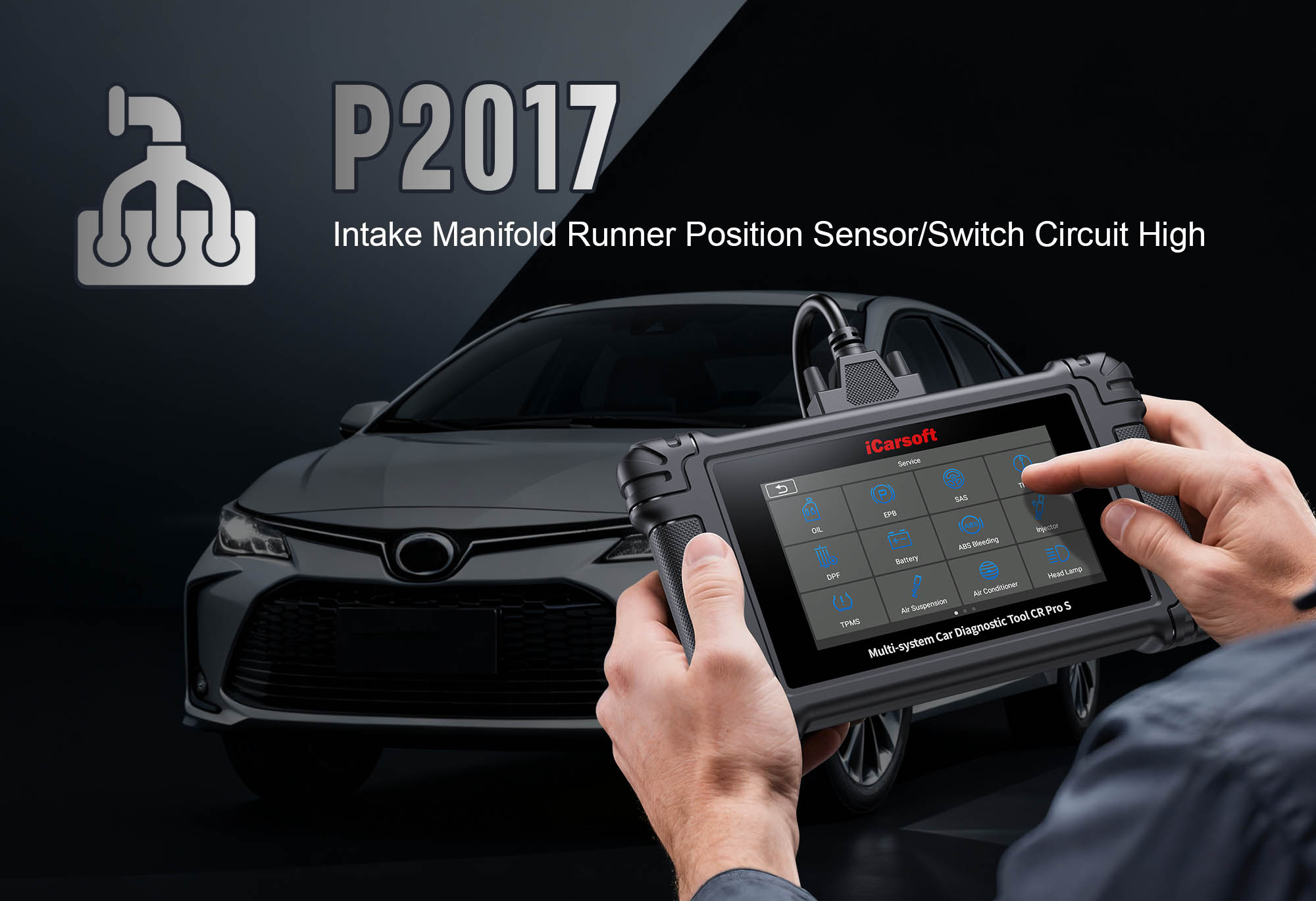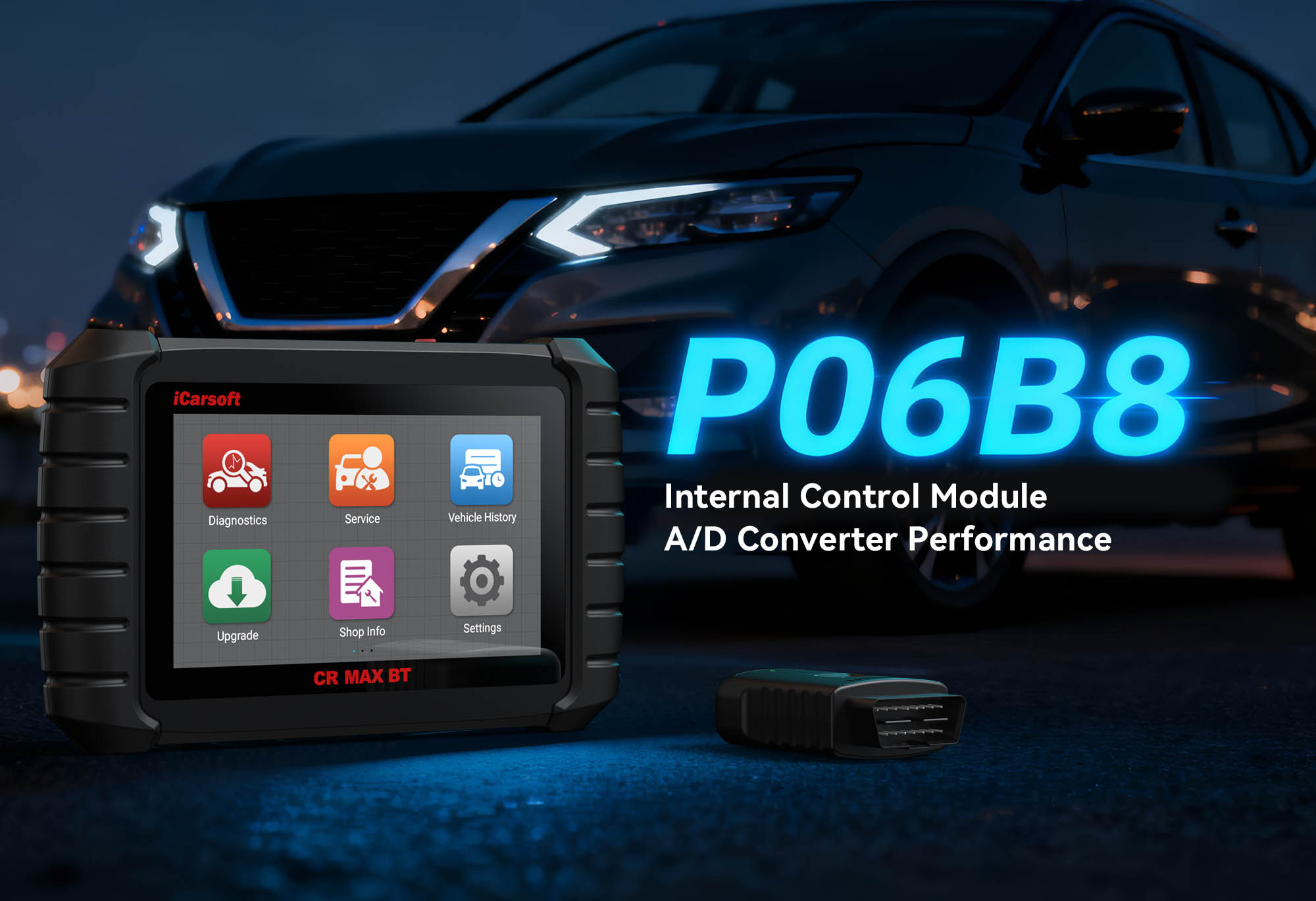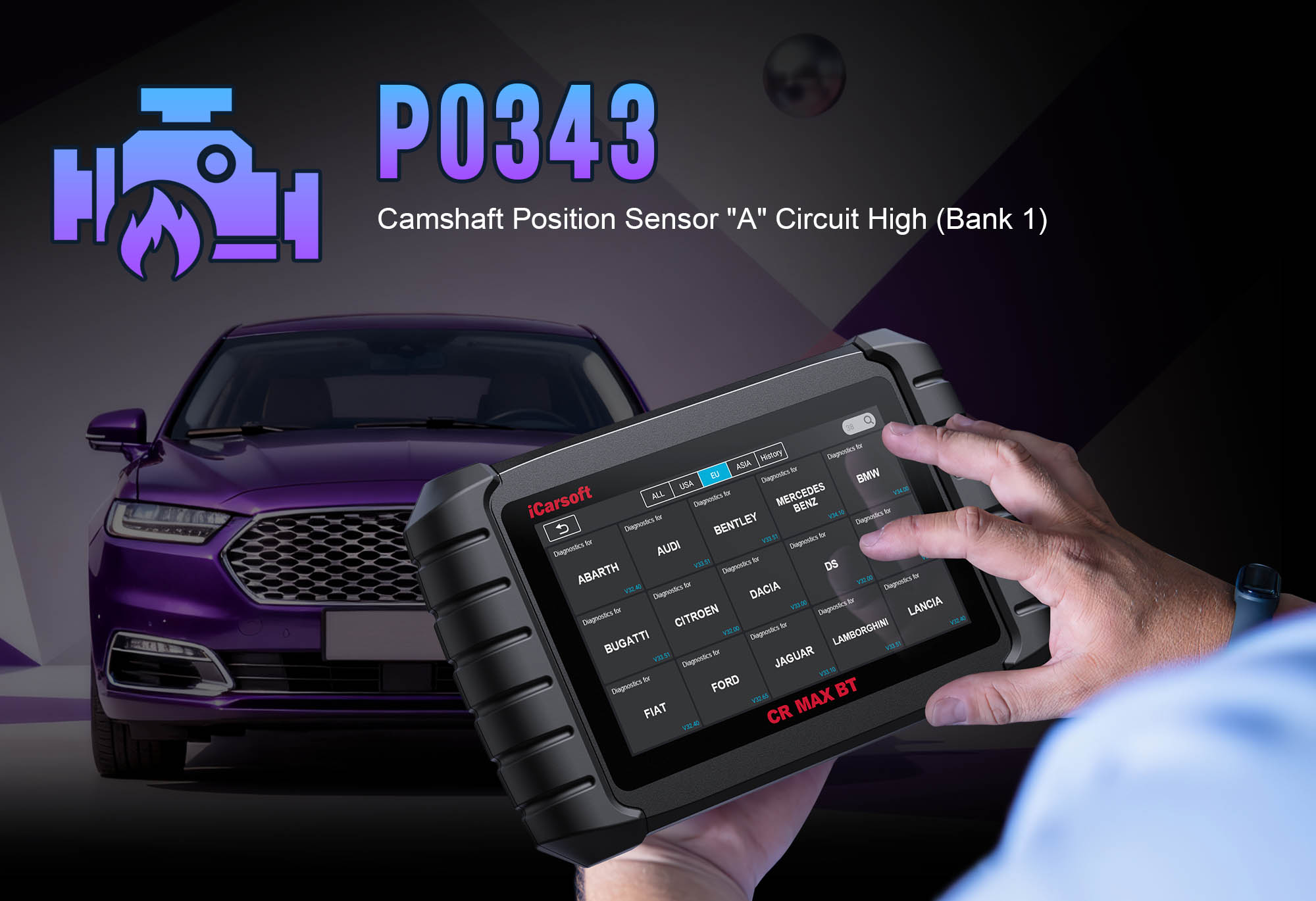Understand & Fix P2017: Intake Manifold Runner Position Sensor/Switch Circuit Range/Performance (Bank 1) with iCarsoft CR Pro S
If your vehicle exhibits rough idling, reduced power during acceleration, or poor fuel economy, a diagnostic scan will likely return P2017. This OBD-II code stands for "Intake Manifold Runner Position Sensor/Switch Circuit Range/Performance (Bank 1)"—a critical fault targeting the intake manifold runner control (IMRC) system. The IMRC system adjusts the intake manifold’s internal geometry to optimize airflow for different engine speeds: wider runners for high RPM (max power) and narrower runners for low RPM (better torque). A "range/performance" error means the Engine Control Module (ECM) detects signals from the IMRC position sensor outside the normal range, disrupting combustion efficiency.
Basic scanners might only flag a "generic intake error" but can’t test IMRC actuator responsiveness, verify sensor calibration, or check circuit integrity—leaving you guessing between a faulty sensor, stuck actuator, or wiring issues. The iCarsoft CR Pro S, with its OE-level engine diagnostics, bi-directional control, and live data tracking, solves this. Below, we break down P2017, its causes, symptoms, step-by-step resolution, and 8 FAQs to answer common troubleshooting questions.
What Is P2017?
P2017 focuses on the intake manifold runner position sensor/switch circuit for Bank 1 (Bank 1 refers to the cylinder bank containing the number 1 cylinder). The IMRC system consists of a position sensor (which monitors the runner’s position) and an actuator (electric or vacuum-operated) that adjusts the runner’s geometry. The ECM relies on the sensor’s signal to confirm the actuator has moved to the correct position; a "range/performance" error indicates the signal is too high, too low, or erratic—signaling a malfunction in the sensor, actuator, wiring, or intake passages.
Key Symptoms of P2017
-
Illuminated Check Engine Light: The primary warning sign, often paired with codes like P2015 (Bank 1 intake manifold runner position sensor circuit malfunction) or P0171 (system too lean).
-
Rough Idling & Misfires: Incorrect intake airflow disrupts the fuel-air mixture at low speeds, causing engine shaking.
-
Reduced Acceleration & Power: Restricted or unregulated airflow limits engine output, especially during hard acceleration.
-
Poor Fuel Economy: Imbalanced fuel-air mixture increases consumption by 10–15%.
-
Engine Hesitation: Delayed response when pressing the gas pedal due to mismatched airflow and fuel injection.
-
Cold Start Issues: Harder cranking or prolonged warm-up as the IMRC system fails to optimize airflow for cold conditions.
Common Causes of P2017
|
Cause
|
Description
|
|
Faulty IMRC Position Sensor
|
Worn internal components or electrical failure leading to erratic signal output.
|
|
Stuck/Broken IMRC Actuator
|
Electric motor or vacuum diaphragm failure preventing runner position adjustment.
|
|
Clogged Intake Passages
|
Carbon buildup or debris blocking the intake manifold runners, restricting movement.
|
|
Wiring/Circuit Issues
|
Frayed wires, corroded connectors, or loose terminals disrupting signal/voltage to the sensor/actuator.
|
|
Low Vacuum Pressure (vacuum-operated)
|
Leaks in vacuum hoses reducing actuator performance.
|
|
ECM Malfunction
|
Rarely, the ECM’s internal driver fails to interpret sensor signals correctly.
|
Why iCarsoft CR Pro S Excels at Diagnosing P2017
The CR Pro S outperforms basic tools with features tailored to IMRC system diagnostics:
Live Position Sensor Tracking
Monitors IMRC sensor voltage in real time, highlighting deviations from 0.5V–4.5V that trigger P2017.
Bi-Directional Actuator Testing
Sends commands to IMRC actuator to verify responsiveness—distinguishes actuator from sensor/wiring faults.
Global Vehicle Coverage
Supports 50+ brands with IMRC systems, including gasoline and diesel models (Mercedes-Benz, BMW, Ford, etc.).
40+ Hot Service Functions
Includes IMRC calibration, intake cleaning reset, and actuator relearn—critical for post-repair validation.
Component Location Tool
Pinpoints IMRC sensor/actuator (on intake manifold) and related wiring for quick access.
Circuit Continuity & Resistance Checks
Built-in multimeter tests for shorts, opens, and voltage drops in the IMRC circuit.
Step-by-Step: Diagnose P2017 with iCarsoft CR Pro S
-
Confirm P2017 & Gather Data
Plug the CR Pro S into your vehicle’s OBD-II port, power on the tool, and select AutoVIN Identify to auto-detect make, model, and cylinder bank configuration.
Navigate to Engine > Fault Codes > Read Codes to confirm P2017. Tap Code Details for model-specific insights (e.g., "Toyota Camry: Bank 1 IMRC Position Sensor Circuit Range/Performance; Signal: 0.3V, Expected: 0.5–4.5V; Check Sensor or Actuator").
-
Analyze Live IMRC System Data
Go to Engine > Live Data > Intake System and monitor three key metrics:
1. IMRC Position Sensor Voltage: Fluctuates with engine speed (0.5V at idle, 4.0V at high RPM). Fixed/out-of-range values confirm P2017.
2. Actuator Control Signal: Verifies ECM commands to actuator (should match sensor feedback if working).
3. Engine Load & RPM: Mismatched load/RPM vs. IMRC signal = circuit/component failure.
-
Test the IMRC Sensor & Actuator
1. Use Bi-Directional Control > Engine > IMRC Actuator Test: Send extend/retract commands. Listen for clicking and check sensor voltage adjustment. No response = faulty actuator.
2. Locate sensor/actuator: Use the CR Pro S’s Component Location tool (on intake manifold).
3. Inspect & Test: Check for damage, carbon buildup, or oil contamination. Use Resistance Test (match OEM specs, e.g., 10–50 ohms—open/infinite = faulty sensor).
-
Inspect Wiring, Intake Passages, & Vacuum Hoses
1. Wiring Check: Use Continuity Test on IMRC circuit wiring for breaks/shorts. Look for damage near heat sources or moving parts.
2. Intake Passages Check: Remove manifold (if accessible) and clean carbon buildup. Use Cylinder Misfire Check to rule out combustion issues.
3. Vacuum Hoses Check (vacuum-operated): Inspect for cracks/leaks. Use Vacuum Leak Test (if supported) to verify pressure.
-
Repair & Clear the Code
- Replace faulty IMRC sensor/actuator if defective. Repair wiring, clean intake passages, or fix vacuum leaks.
- Use the CR Pro S to Clear Codes and run IMRC System Calibration (under Special Functions) to sync with ECM.
- Test drive 50–100 miles. Monitor live data to ensure stable airflow and engine performance.
FAQs: P2017 Troubleshooting
Can I drive with P2017?
Short trips are possible, but prolonged driving worsens engine efficiency and risks damage to spark plugs or the catalytic converter. Diagnose with the CR Pro S immediately.
How much does it cost to fix P2017?
A new IMRC sensor costs $50–$150, an actuator costs $80–$300, plus $100–$200 for labor. Intake cleaning adds $150–$300. The CR Pro S saves on diagnostic fees ($100–$250).
Why does P2017 keep returning after clearing it?
The root cause wasn’t fixed. Common culprits: unaddressed carbon buildup, hidden wiring damage, or a failing ECM. Use the CR Pro S’s History Log to track recurrence.
What’s the difference between P2017 (Bank 1) and P2021 (Bank 2)?
P2017 targets the Bank 1 IMRC system, while P2021 affects Bank 2. The CR Pro S’s cylinder bank identification tool distinguishes these faults.
How do I distinguish between a faulty sensor and actuator?
Compare live data: Actuator responds + erratic sensor signal = faulty sensor; Actuator doesn’t respond + normal sensor signal = faulty actuator.
Do I need to calibrate the IMRC system after replacement?
Yes—use the CR Pro S’s IMRC Calibration function to ensure the ECM recognizes the new component and adjusts airflow correctly.
Can carbon buildup cause P2017?
Yes—clogged intake passages prevent the actuator from moving the runners, misleading the sensor. Use the CR Pro S’s Live Data to check for restricted movement.
Will P2017 affect emissions?
Yes—imbalanced fuel-air mixture increases harmful emissions (HC, CO) and may cause an emissions test failure. Fix P2017 with the CR Pro S to ensure compliance.
Conclusion
P2017’s IMRC system fault disrupts engine performance and efficiency, but the iCarsoft CR Pro S simplifies diagnosis with live signal tracking, bi-directional testing, and calibration tools. It ensures you fix the root cause—whether it’s a faulty sensor, stuck actuator, or wiring issues—instead of just clearing the code.
With a 5-inch touchscreen, lifetime free updates, and coverage for 50+ brands, the CR Pro S is a must-have for DIYers and mechanics. Resolve P2017, restore optimal airflow, and avoid costly engine damage—all with one professional-grade diagnostic scanner.





